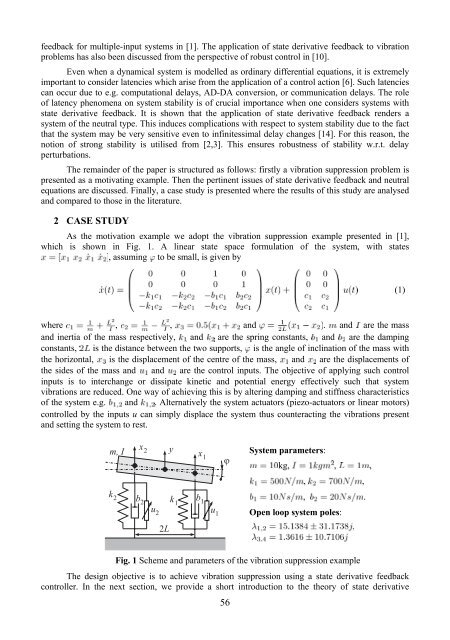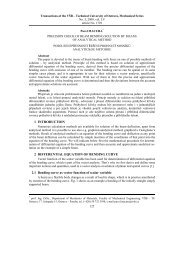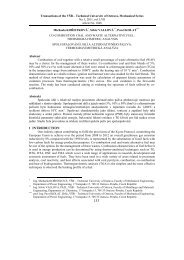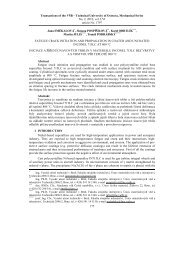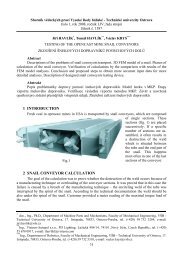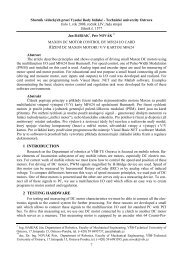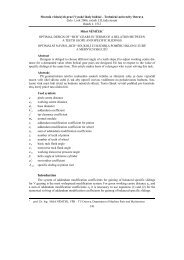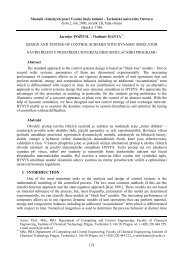SbornÃk vÄdeckých pracà Vysoké Å¡koly báÅské ... - Transactions
SbornÃk vÄdeckých pracà Vysoké Å¡koly báÅské ... - Transactions
SbornÃk vÄdeckých pracà Vysoké Å¡koly báÅské ... - Transactions
You also want an ePaper? Increase the reach of your titles
YUMPU automatically turns print PDFs into web optimized ePapers that Google loves.
feedback for multiple-input systems in [1]. The application of state derivative feedback to vibration<br />
problems has also been discussed from the perspective of robust control in [10].<br />
Even when a dynamical system is modelled as ordinary differential equations, it is extremely<br />
important to consider latencies which arise from the application of a control action [6]. Such latencies<br />
can occur due to e.g. computational delays, AD-DA conversion, or communication delays. The role<br />
of latency phenomena on system stability is of crucial importance when one considers systems with<br />
state derivative feedback. It is shown that the application of state derivative feedback renders a<br />
system of the neutral type. This induces complications with respect to system stability due to the fact<br />
that the system may be very sensitive even to infinitessimal delay changes [14]. For this reason, the<br />
notion of strong stability is utilised from [2,3]. This ensures robustness of stability w.r.t. delay<br />
perturbations.<br />
The remainder of the paper is structured as follows: firstly a vibration suppression problem is<br />
presented as a motivating example. Then the pertinent issues of state derivative feedback and neutral<br />
equations are discussed. Finally, a case study is presented where the results of this study are analysed<br />
and compared to those in the literature.<br />
2 CASE STUDY<br />
As the motivation example we adopt the vibration suppression example presented in [1],<br />
which is shown in Fig. 1. A linear state space formulation of the system, with states<br />
, assuming to be small, is given by<br />
(1)<br />
where , , and . and are the mass<br />
and inertia of the mass respectively, and are the spring constants, and are the damping<br />
constants, is the distance between the two supports, is the angle of inclination of the mass with<br />
the horizontal, is the displacement of the centre of the mass, and are the displacements of<br />
the sides of the mass and and are the control inputs. The objective of applying such control<br />
inputs is to interchange or dissipate kinetic and potential energy effectively such that system<br />
vibrations are reduced. One way of achieving this is by altering damping and stiffness characteristics<br />
of the system e.g. and . Alternatively the system actuators (piezo-actuators or linear motors)<br />
controlled by the inputs u can simply displace the system thus counteracting the vibrations present<br />
and setting the system to rest.<br />
x<br />
m, I 2 y<br />
x System parameters:<br />
1<br />
<br />
kg, , ,<br />
, ,<br />
k 2 b 2 k 1<br />
b 1<br />
u 2<br />
2L<br />
u 1<br />
, .<br />
Open loop system poles:<br />
Fig. 1 Scheme and parameters of the vibration suppression example<br />
The design objective is to achieve vibration suppression using a state derivative feedback<br />
controller. In the next section, we provide a short introduction to the theory of state derivative<br />
56


